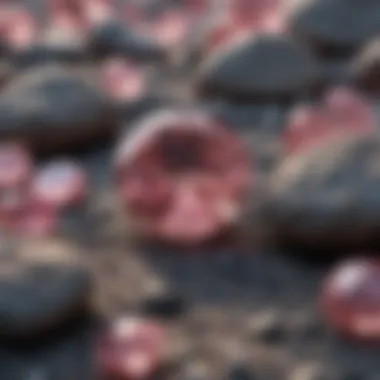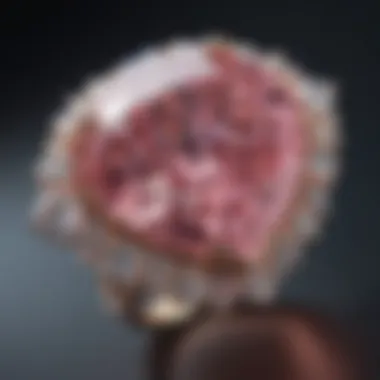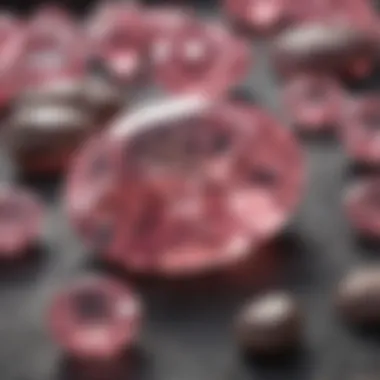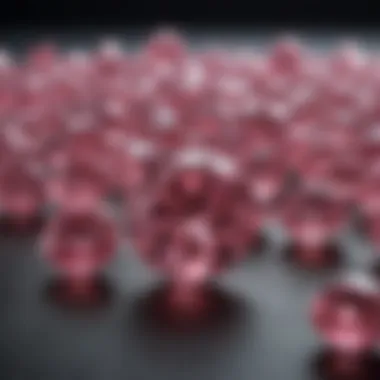The Enigmatic Allure of Pink Diamonds Revealed


Intro
Pink diamonds constitute a unique segment within the broader category of gemstones. Their captivating coloration and rarity often evoke admiration, yet they remain shrouded in mystery for many. This article delves into various aspects of pink diamonds, revealing their geological formation, assessing their market value, and examining their authenticity and cultural significance. Collectors, enthusiasts, and jewelry designers alike will find valuable insights that shed light on the reality surrounding these sought-after stones.
Gemstone Overview
Definition and Characteristics
Pink diamonds are a variation of natural diamonds that exhibit a pink hue. Their color can range from light blush to a vibrant magenta, largely depending on their specific formation and sources. Contrary to popular beliefs, the color is not due to any impurities in the diamond's carbon structure but rather a result of unique geological processes that affect its crystal lattice. This structural deformity influences the way light enters and reflects off the diamond, creating that characteristic pink shade. Furthermore, pink diamonds are graded by the intensity of their color, with the most vivid stones fetching the highest prices in the market.
Classification of Gemstones
Gemstones can be broadly classified into precious and semi-precious categories. Pink diamonds, classified as precious gemstones, are distinguished by their rarity and the specific qualities that elevate their status. These qualities include their durability, brilliance, and, most importantly, their color. The gemological community uses the Four Cs—Carat, Cut, Color, and Clarity—to evaluate diamonds. In the context of pink diamonds, color can significantly vary, leading to more nuanced classifications such as Fancy Light Pink, Fancy Pink, and Fancy Intense Pink.
In addition to color classification, the market segments pink diamonds further based on their origins. The Argyle mine in Australia was once the premier source of pink diamonds, although many other sites have emerged globally. Understanding this classification can help collectors recognize the value associated with different pink diamond types.
Historical Significance
Ancient Uses and Cultural Importance
From antiquity, gemstones, including pink diamonds, have held symbolic meaning in various cultures. Historically, diamonds were believed to possess protective qualities and were often associated with power and wealth. Pink diamonds, while less prominent in ancient societies compared to their clear counterparts, were still valued for their beauty and rarity. In historical texts, gemstones were often attributed metaphysical properties like enhancing emotional stability and fostering love.
Myths and Legends Surrounding Gemstones
Throughout history, pink diamonds have inspired numerous myths and legends. Stories often depict them as talismans of romantic love, believed to bring its bearer luck and fidelity. Such spheres of belief tend not only to elevate emotional connections to these gems but also contribute to the high demand and market valuation.
"The allure of pink diamonds transcends mere aesthetics; they encapsulate rich narratives that resonate with the human experience of love, power, and aspiration."
In summary, pink diamonds represent more than just luxurious adornments. Their origins, market dynamics, and cultural relevance entwine to form a complex and fascinating narrative that compels further exploration within the realm of gemstones.
Prelude to Pink Diamonds
The allure of pink diamonds captivates gem enthusiasts and collectors alike. Their unique color and rarity have merged to create a fascination that extends beyond mere aesthetics. In this section, we will delve into the importance of understanding pink diamonds, as they represent a significant aspect of gemstone lore.
Understanding pink diamonds is crucial not only for collectors but also for investors and jewelry designers. The distinct characteristics of these diamonds can inform buyers about their value and authenticity. Moreover, their history enriches our knowledge of geological processes and cultural associations. This deeper understanding allows individuals to appreciate the complexity of pink diamonds and the factors that influence their market dynamics.
Some key points to consider:
- The value of pink diamonds in comparison to other colored diamonds can significantly impact investment decisions.
- Knowledge of how these diamonds are formed allows for a greater appreciation of their rarity.
- Historical context sheds light on cultural significance and symbolism associated with the color pink in jewelry.
As we explore the definition, characteristics, and historical context of pink diamonds, it is essential to recognize their unique place in both geology and jewelry. This exploration will set the stage for understanding their geological origins, authenticity verification, and market valuation.
Definition and Characteristics
Pink diamonds are a specific type of colored gemstone classified within the broader diamond category. They are known for their distinctive pink hue, a result of complex geological conditions. The depth and intensity of the pink color can vary significantly, ranging from soft blush to vivid shades. This variation contributes to a wide spectrum of values, making certain shades exceedingly rare and highly sought after.
One important characteristic of pink diamonds is their clarity. Many possess very high levels of clarity, making them perfect for exquisite settings in fine jewelry. However, some diamonds may display inclusions, which can influence their market price.


Another aspect worth noting is the unique crystallographic structure of pink diamonds. These stones exhibit a specific type of distortion in their crystal lattice due to their formation processes, which not only contributes to their color but also affects their overall brilliance.
Historical Context
The history of pink diamonds is intertwined with their discovery and subsequent popularity. The earliest pink diamonds were found in the Golconda mines of India in the 17th century. These mines produced some of the most famous diamonds in history, including the Hope Diamond and the Regent Diamond. Over time, the focus of pink diamond mining shifted to Australia, particularly the Argyle mine, which became known for its substantial contributions to the global pink diamond supply.
The importance of pink diamonds has grown due to their increasing rarity, especially after the closure of the Argyle mine in 2020. This event has sparked heightened interest in the remaining pink diamonds on the market and led to speculation about future prices.
Culturally, pink diamonds often carry symbolic meanings. They are frequently associated with love, romance, and femininity. Their unique color has made them a popular choice for engagement rings and other jewelry pieces, reflecting personal milestones and traditions. Understanding this historical and cultural backdrop enriches our appreciation of pink diamonds and their allure.
Geological Origins of Pink Diamonds
The geological origins of pink diamonds play a vital role in understanding their uniqueness as a gemstone. Unlike conventional diamonds, the pink variety undergoes a specific set of conditions that lead to their distinctive coloration and rarity. This section will delve into the formation process and their geographical distribution, both of which are essential in grasping the full reality of these remarkable stones.
Formation Process
Pink diamonds are formed in the Earth’s mantle, deep beneath the surface, under extreme heat and pressure. The intricate process begins around 150 to 200 kilometers underground. Here, carbon atoms are subjected to intense conditions that allow them to crystallize into diamonds. However, the formation of pink diamonds involves additional complexities.
The unique pink hue is believed to arise from a phenomenon known as lattice distortion. This occurs when the diamond’s crystal structure is subjected to intense stress, which disrupts the regular arrangement of carbon atoms. Such distortion can be the result of tectonic forces that shape the Earth's surface. The better understanding of this process helps to distinguish pink diamonds from their colorless counterparts, emphasizing their rarity and the geological conditions that contribute to their formation.
Geographical Distribution
Key Mining Regions
The key mining regions for pink diamonds are notably limited, contributing to their exclusivity and value. Australia has been home to the majority of the world's pink diamond production, especially from the Argyle mine. This region is unique due to its geological history and the specific conditions under which pink diamonds form. The Argyle mine has been a major source, producing over 90% of the world's supply of pink diamonds.
The characteristic of the Argyle mine is its specific geological settings that favor the formation of colored diamonds. The higher concentrations of pink diamonds in this region have solidified its reputation as an essential locality for these gems. As the mine is nearing depletion, this poses a significant advantage for the remaining pink diamonds; it escalates their value and status as collectible pieces.
Comparison with Other Colored Diamonds
When discussing pink diamonds, it is crucial to compare them with other colored diamonds to appreciate their unique status. Unlike blue or yellow diamonds, which have their color derived from the presence of boron or nitrogen, the pink diamonds’ color arises from structural anomalies. This difference is a significant factor in their valuation.
Simply put, pink diamonds hold a distinct position in the market due to their limited supply and distinctive formation characteristics. This sets them apart in terms of investment potential.
In terms of market trends, pink diamonds have tended to outpace other colored diamonds in terms of value appreciation. Despite the differences in color origins, pink diamonds continue to capture the interest of collectors, jewelry designers, and enthusiasts alike. Understanding these unique qualities strengthens the case for their place within the gemstone industry.
The Authenticity of Pink Diamonds
Understanding the authenticity of pink diamonds is essential for both collectors and investors in the gemstone market. Pink diamonds stand out due to their rarity and unique color, leading to substantial financial implications. Authenticity verification ensures that buyers are acquiring genuine gemstones, thus preserving their value. Without clear verification, the risk of purchasing a fake or lower-quality diamond increases significantly. Therefore, establishing the authenticity of pink diamonds is a pivotal factor in maintaining their market integrity.
Identification Techniques
Gemological Testing
Gemological testing is a rigorous method used to determine the authenticity of pink diamonds. This process involves detailed examination using specialized equipment. Notably, gemological laboratories employ tools like spectrometers to analyze the diamond’s refractive index and light dispersion. These characteristics are unique to authentic diamonds, making gemological testing a reliable method.
- Key Characteristic: Gemological testing provides a scientific assessment of a diamond’s properties, confirming its identity.
- Popular Choice: It is widely regarded as one of the most authoritative methods for assessing gem quality and authenticity.
- Unique Feature: This testing method often includes certification, adding value by providing proof of the diamond's authenticity.
- Advantages and Disadvantages: The primary advantage is that it delivers reliable results supported by scientific evidence. However, the cost can be a limitation for casual buyers; thus, it is more suitable for serious investors or collectors.


UV Light Examination
UV light examination presents another method for verifying pink diamonds. This technique involves exposing the diamond to ultraviolet light to observe its fluorescence. Many authentic pink diamonds exhibit a unique glow under UV light, which is distinct from synthetic diamonds.
- Key Characteristic: The examination reveals crucial information about the diamond's natural properties.
- Beneficial Choice: It serves as a quick screening tool for jewelers and collectors alike, aiding in the immediate identification of potential fakes.
- Unique Feature: Unlike gemological testing, UV light examination is a less invasive process, allowing for faster assessments.
- Advantages and Disadvantages: One major advantage is the speed of this method, making it accessible for quick checks. However, it should not substitute comprehensive gemological testing since not all authentic diamonds fluoresce.
Lab Certifications
Lab certifications play a crucial role in establishing the authenticity of pink diamonds. Renowned gemological laboratories like the Gemological Institute of America (GIA) provide certification that includes an extensive report on the diamond's characteristics. This document not only verifies the diamond's authenticity but also details its cut, color, clarity, and carat weight.
Having a GIA certificate is often regarded as a gold standard in the industry. Collectors and investors prioritize certified diamonds because the certification guarantees meticulous evaluation and increases resale potential.
Market Trends and Valuation
Market trends and valuation are crucial aspects of understanding pink diamonds. They provide insight into the economic landscape surrounding these unique gemstones. Recognizing the market trends helps collectors and enthusiasts decide when to buy or sell. Valuation reflects a diamond's worth, influenced by various elements like rarity, demand, and quality. Knowing these trends allows one to better navigate the gemstone market effectively.
Pricing Dynamics
Factors Affecting Prices
Several factors significantly affect the prices of pink diamonds. Their rarity plays a major role. As pink diamonds are less common compared to traditional colorless diamonds, their demand often outstrips supply. This imbalance drives prices higher. The quality of the stone also matters. Cut, clarity, and carat weight contribute to the final valuation. For instance, a well-cut pink diamond with high clarity will be valued higher than one with cloudy inclusions.
Moreover, market trends can cause fluctuations and affect perceptions of these stones.
- Market demand: Surging interest can significantly enhance prices.
- Economic factors: Changing economic circumstances can influence purchasing power, thereby affecting valuation.
- Certification: Stones verified by respected gemological institutes like the Gemological Institute of America tend to command better prices.
These factors make pricing dynamics complex yet fascinating. They provide valuable insights for potential investors and buyers.
Comparative Analysis with Other Gems
Comparative analysis with other gems reveals how pink diamonds hold their own in the broader gemstone market. Other colored diamonds, like blue or yellow, are notable, yet pink diamonds often attract more attention and investment. This can be attributed to their limited availability and distinctive appeal.
In comparison to sapphires or rubies, pink diamonds have shown a consistent upward trend in value, especially in the past decade.
- Value retention: They often retain their value better than many other gemstones.
- Fashion trends: Pink diamonds have gained a reputation in celebrity culture, enhancing their desirability.
- Investment potential: When compared to high-end luxury items, pink diamonds often provide a favorable return on investment.
Understanding these factors provides clarity for savvy investors and collectors, helping them make informed decisions.
Investment Potential
The investment potential of pink diamonds is significant. Their rarity and historical appreciation in value make them an attractive option for collectors. Many investors see pink diamonds as an alternative asset class. This provides them with a safe haven, especially during economic uncertainty.
The demand within the luxury jewelry market also propels interest. There are trends toward exclusive and limited-edition jewelry pieces, and pink diamonds often feature prominently in these designs.
When considering investment, potential buyers should assess:
- Market conditions: Understanding the current economic climate
- Authenticity: Ensuring the diamond is genuine and well-documented
- Long-term value: A historical view on how these diamonds appreciate over time


Cultural Significance of Pink Diamonds
Pink diamonds hold a unique position within the realm of gemstones, not just for their physical attributes but also for their profound cultural significance. This section explores how pink diamonds have transcended their mere aesthetic value to become symbols of status, love, and rarity in various cultures. Understanding this significance can provide valuable insights for collectors, jewelry designers, and enthusiasts alike.
Symbolism and Meaning
The meaning of pink diamonds extends beyond their visual appeal. In many cultures, these stones symbolize love and affection. Their soft hue is often associated with romance and emotional intimacy. In recent years, pink diamonds have become prominent in engagement rings, affirming their role as representations of enduring love.
Moreover, the rarity of pink diamonds has imbued them with a sense of exclusivity. With their unique formation process contributing to their limited availability, they are often seen as status symbols among affluent individuals. This status also translates into investment opportunities, making them appealing for those looking to diversify their asset portfolios.
Additionally, some traditions link the color pink to compassion and nurturing. These associations enhance the emotional value of pink diamonds, making them appealing not only as jewelry but also as gifts that convey deep sentiments. The soft tone of pink diamonds contrasts wonderfully with their hardness, making them a suitable metaphor for the complexity of human emotions.
Representation in Fine Jewelry
The prevalence of pink diamonds in high-end jewelry illustrates their cultural importance. Renowned jewelry designers often incorporate these stones into their creations. Their delicate color pairs well with various metals, allowing for versatile design options. From earrings to necklaces, pink diamonds infuse any piece with an element of luxury.
In many cultures, the gifting of jewelry featuring pink diamonds signifies significant life milestones. Birthdays, anniversaries, or significant achievements often prompt the selection of pink diamond pieces, reinforcing the stone's connection to personal growth and celebration.
In contemporary markets, brands such as Graff and Tiffany & Co. showcase striking designs that highlight pink diamonds, further cementing their status in popular culture. The presence of these diamonds in media and fashion also influences public perception, often linking them with glamour and sophistication.
"Pink diamonds have evolved from mere gemstones into integral components of cultural identity, weaving stories of love, celebration, and aspiration."
In summary, the cultural significance of pink diamonds is multifaceted, encompassing themes of love, status, and tradition. As the demand for these stones continues to grow, understanding their cultural importance becomes crucial for anyone involved in the gemstone industry.
Care and Maintenance of Pink Diamonds
Caring for pink diamonds is not just about preserving their beauty; it is also essential for maintaining their value. Like any high-value gemstone, pink diamonds require special attention to ensure they remain in their best condition over time. Proper care and maintenance contribute significantly to extending their lifespan and enhancing their brilliance.
Cleaning Techniques
When it comes to cleaning pink diamonds, it is important to choose methods that are both safe and effective. Here are some recommended techniques:
- Mild Soap Solution: Use a mixture of warm water and a few drops of mild dish soap. Soak the diamond for about 20–30 minutes.
- Soft Brush: After soaking, gently scrub with a soft-bristled toothbrush to remove any dirt or grime. Avoid hard brushes that can scratch the diamond.
- Rinse Thoroughly: It is crucial to rinse the diamond well under a stream of warm water to remove any soap residue.
- Drying: Pat the diamond dry with a soft, lint-free cloth. Avoid using paper towels or rough fabrics, as they can create scratches.
Remember to clean your pink diamond regularly, especially if you wear it frequently. Feeding the diamond to dirt and oils from your skin can dull its shine.
Storage Recommendations
Storing pink diamonds properly is equally important as cleaning. Here are key considerations for storing your diamond:
- Separate Storage: Store pink diamonds separately from other jewelry items. Placing them in a soft pouch or a lined jewelry box helps avoid scratches or damage.
- Temperature Control: Avoid exposing diamonds to extreme temperatures. High heat can cause damage, so store them in a cool, stable environment.
- Humidity Consideration: A high-humidity environment can lead to tarnishing of metal settings. Make sure to store them in a dry place.
- Avoid Areas with Chemicals: Keep pink diamonds away from chemicals, such as those found in household cleaners and beauty products. These substances can damage both the diamond and any settings.
Taking care of your pink diamond through proper cleaning and storage not only preserves its physical beauty but also retains its appeal for potential buyers or collectors. This investment in maintenance ensures that the diamond continues to shine and remain a cherished possession.
End
In this article, we delved into the captivating world of pink diamonds, examining their allure from various angles. Understanding pink diamonds goes beyond mere appreciation of their beauty. It requires acknowledging their geological rarity, market dynamics, and cultural significance.
The rarity of pink diamonds influences their market value significantly. As noted in previous sections, the limited geographical distribution and complex formation processes produce a gemstone that is not only visually stunning but also intrinsically valuable. This knowledge can inform potential investors and collectors about the best approaches to acquisition and valuation.
Furthermore, the cultural significance of pink diamonds adds layers to their appeal. The symbolism attached to these gems enhances their desirability and standing in the fine jewelry market. Consequently, understanding how these diamonds are viewed in various cultures can provide insights for collectors and designers alike.
From the identification techniques discussed, it is clear that ensuring the authenticity of pink diamonds is paramount in the purchasing process. With the right knowledge and tools, consumers can navigate the market more effectively, safeguarding their investments.
Important note: Always seek expert opinions and verification when dealing with high-value gems to ensure authenticity and maximize value.







